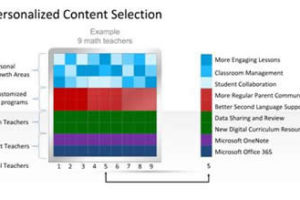When most teachers receive professional development regarding a technology tool, they are often provided a “this is how you use this” workshop. At Phoenix Union High School District, a portfolio district in Arizona, we’ve found that personalized professional development gives teachers a voice in their learning, which makes the experience much more powerful for them.
A personalized approach revolves around the following questions:
• What do you want to do?
• What tools are available to you?
• What is stopping you from using those tools more regularly?
Related content: 5 ways to make sure PBL PD works
Our work with edtech professional development really began in 2011 and was sparked by data showing a strong correlation between freshmen passing Algebra 1 and graduating high school. We wanted to determine how our teachers could (1) differentiate instruction more effectively, (2) create an early warning system to identify children who needed reteaching or intervention, and (3) leverage technology to facilitate those two endeavors.
For those efforts, we used a Learner Response System and ensured that a wide range of professional development was provided to each and every Algebra 1 teacher. We saw real success with this PD approach and expanded the program beyond just Algebra 1 to open the door to a teacher-centric personalized professional development approach that meets the changing needs of individual teachers as well as our diverse schools; Phoenix Union has nine comprehensive high schools, four specialty schools, one college and career magnet school, three support schools, two micro schools [schools within schools], and one virtual academy.
Working with professional development company EOS Education, we have aligned our professional development program to the district’s strategic plan. We look at how technology can facilitate our district-wide initiatives, content-area programs, plans for special populations, and pilot projects. We also look at where to find efficiencies in terms of tools already being used, teachers’ existing knowledge, or ways to provide professional learning opportunities.
As the diagram below shows, we have all district teachers learn how to use Microsoft Office 365 and Microsoft OneNote so they have fundamental knowledge before they focus on higher-level strategies that use technology in more sophisticated ways.
Content area specialists, e.g. math teachers, also have to learn strategies around data sharing and reviews (e.g., sharing assessments, becoming comfortable with a digital curriculum and looking at students collectively rather than in class silos). Additionally, each school site is so different that they are unique micro-systems, which means that teachers may need to do professional development that addresses the specific site needs of their school. For example, one school may need second language support while another needs help with regular parental communication.
However, at the top of the chart are teachers’ individual growth goals. Incorporating those personal growth areas into the bigger professional development plan has been an excellent way to keep everyone engaged and working together.
We found that we need to create a lot of different personalized professional development opportunities, both online and in-person, so teachers can select what fits their learning style and schedule. Our program also allows teachers to choose from a spectrum of topics, including, but not limited to, how to make materials accessible for special needs students; how to enhance project-based learning with technology, and more.
Trainers even go to classrooms and observe teachers in order to suggest ideas and work with them on individual lesson plans. Trainers also work with students to ensure they are comfortable with the technology so everyone can focus on teaching and learning.
Additionally, support at the implementation stage is necessary to make teachers feel comfortable enough to start using technology by themselves in the classroom, experimenting and even making mistakes in front of students. According to the Center for Public Education, teachers need an average of 20 instances of practice to implement a new routine. Therefore, we have to be flexible when providing support. Teachers may practice throughout the day, in their prep period, before or after school, or on Saturdays. EOS provides online support for teachers who have a quick question as well as “boots on the ground” support.
Our personalized professional development program also incorporates badging. The process for getting a badge is to attend training, complete a short assessment, and also submit an artifact from classroom implementation. That last requirement helps teachers practice what they learned. Hundreds of teachers have been awarded thousands of badges from more than 75 different tech-based and instructional strategy-based topics.
We believe effective professional development should provide teachers with the opportunity to engage in meaningful collaboration, with dexterous technology users helping their less experienced or less enthused peers. Our Professional Learning Communities (PLCs) take place every Wednesday morning, and one bonus is that as members of the PLC share data and ideas, they see the possibilities of what students can achieve by collaborating.
Shifting to a teacher-centered personalized professional development approach has benefited Phoenix Union tremendously. Our teachers have progressed from almost 100 percent being edtech beginners to just 20 percent now being at the beginner level. Additionally, both our enrollment and graduation rates are the highest they’ve ever been. Plus, leaders now have a way to ensure that visionary plans make it down to the teacher and classroom level. In short, this professional development model has proven critical to advance learning for all.
- 7 reasons to ditch recipe-style science labs - November 22, 2024
- As a paradeducator, here’s how I use tech to help neurodivergent students gain agency - November 22, 2024
- 5 ways school districts can create successful community partnerships - November 21, 2024


